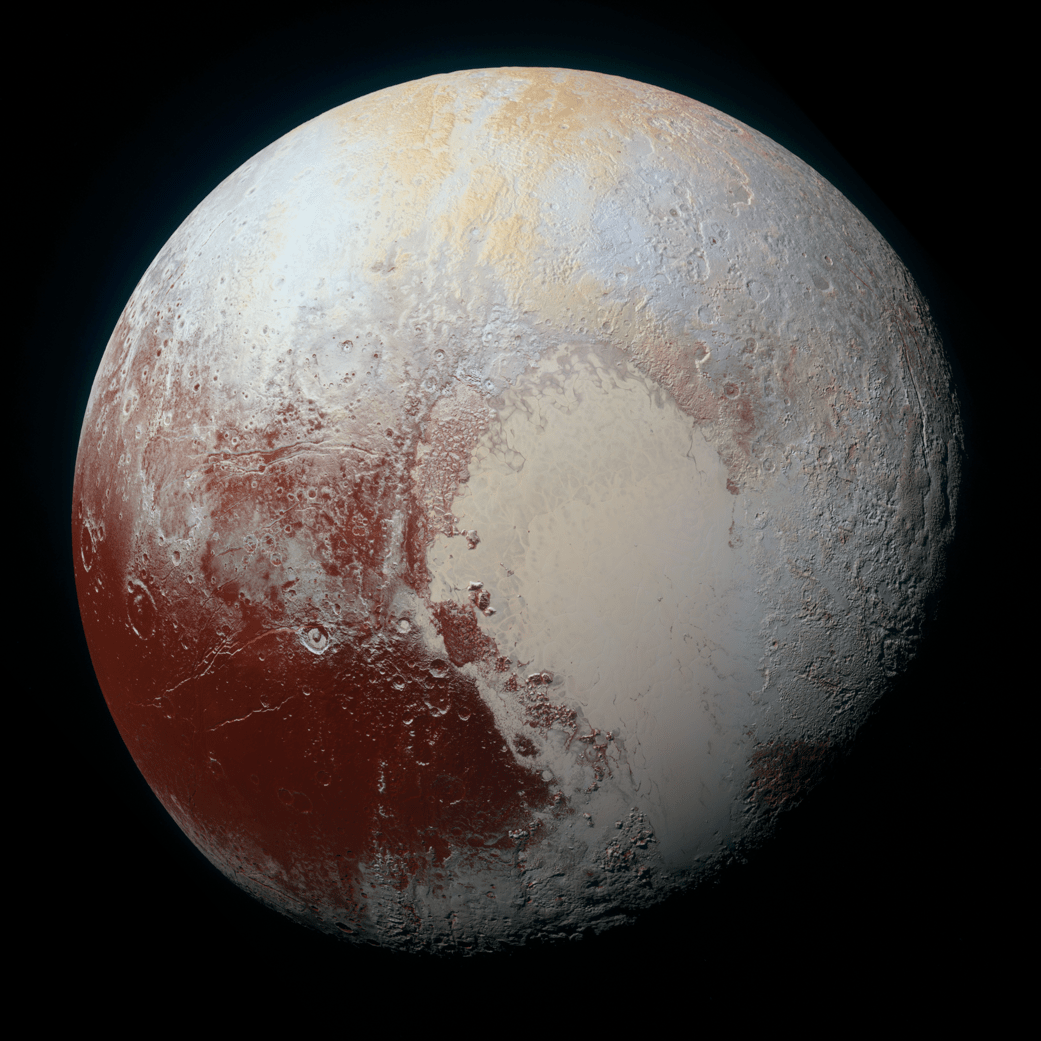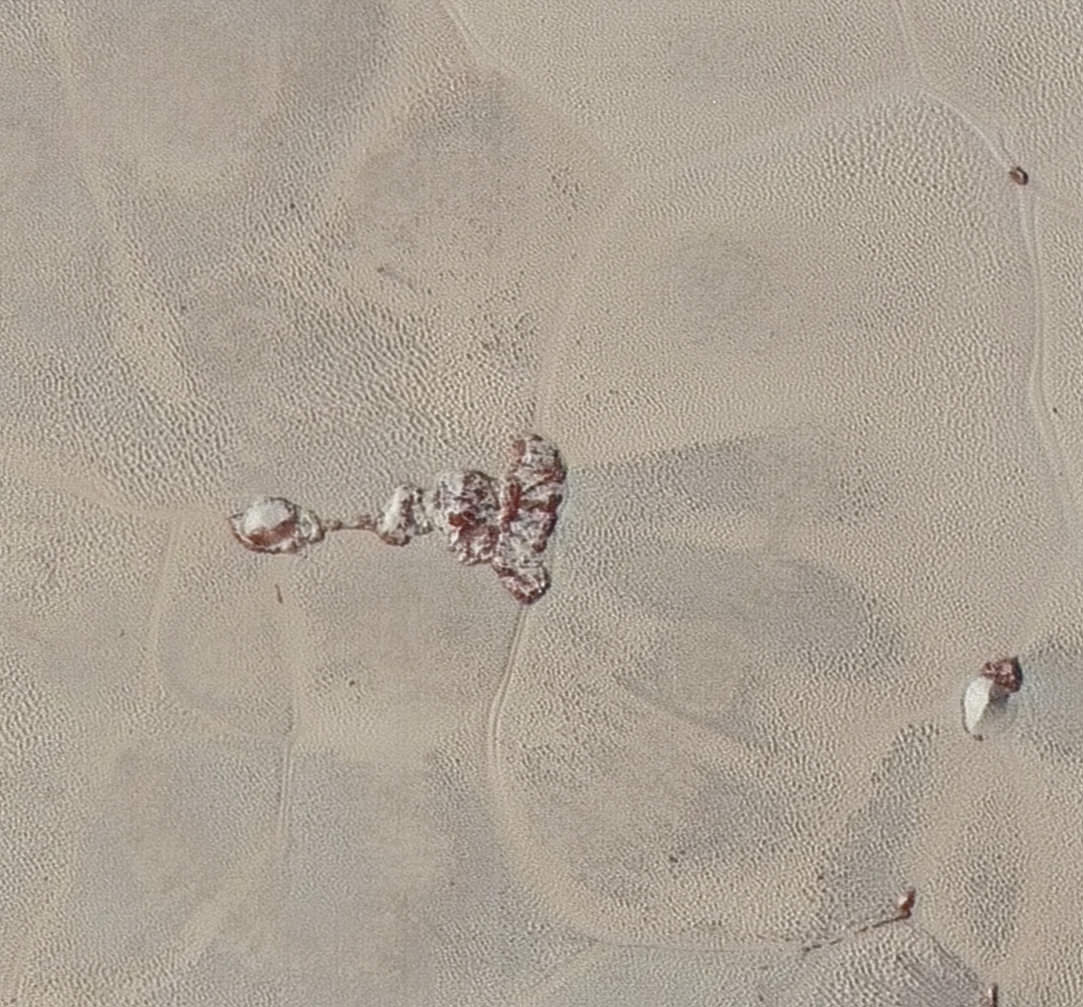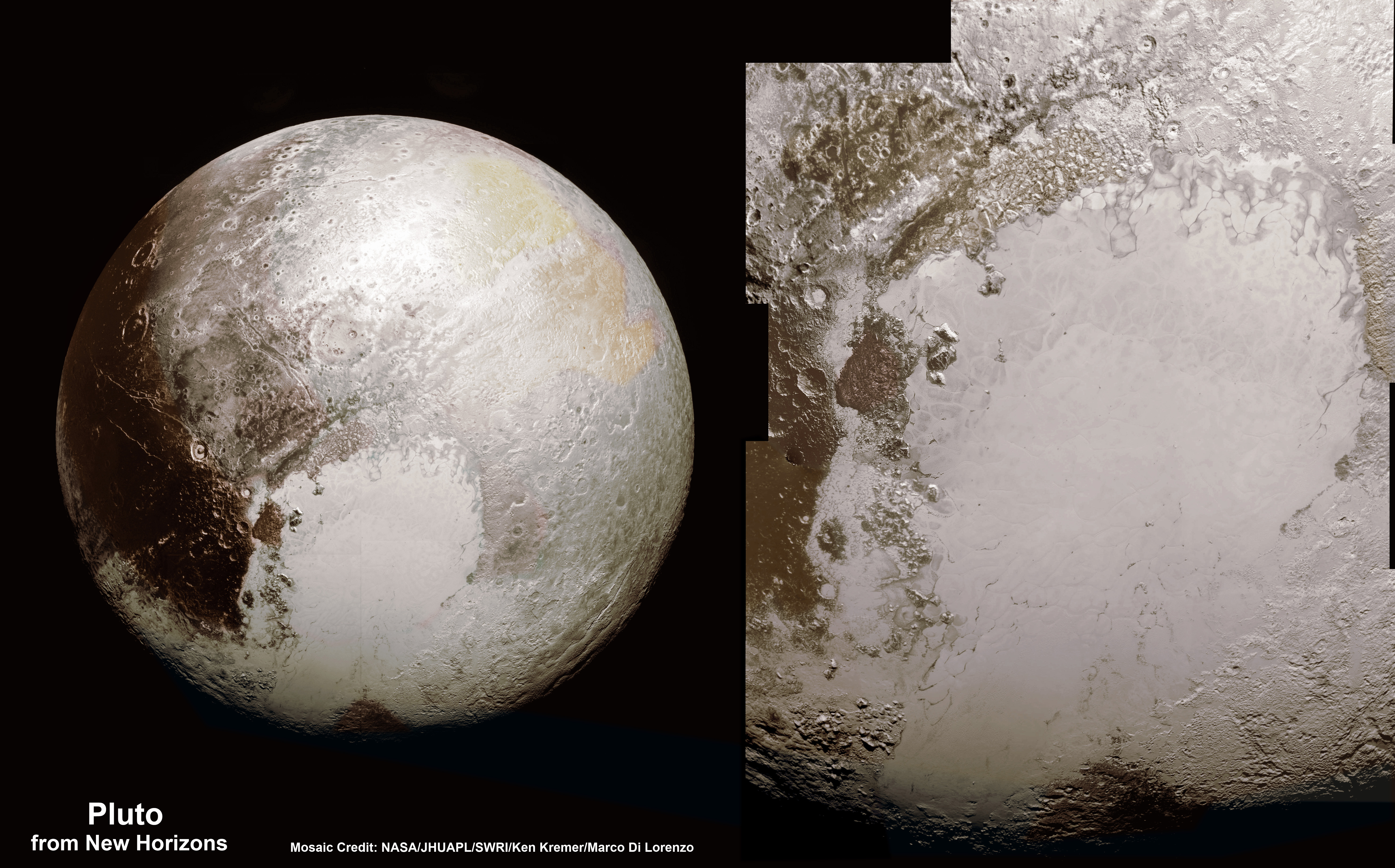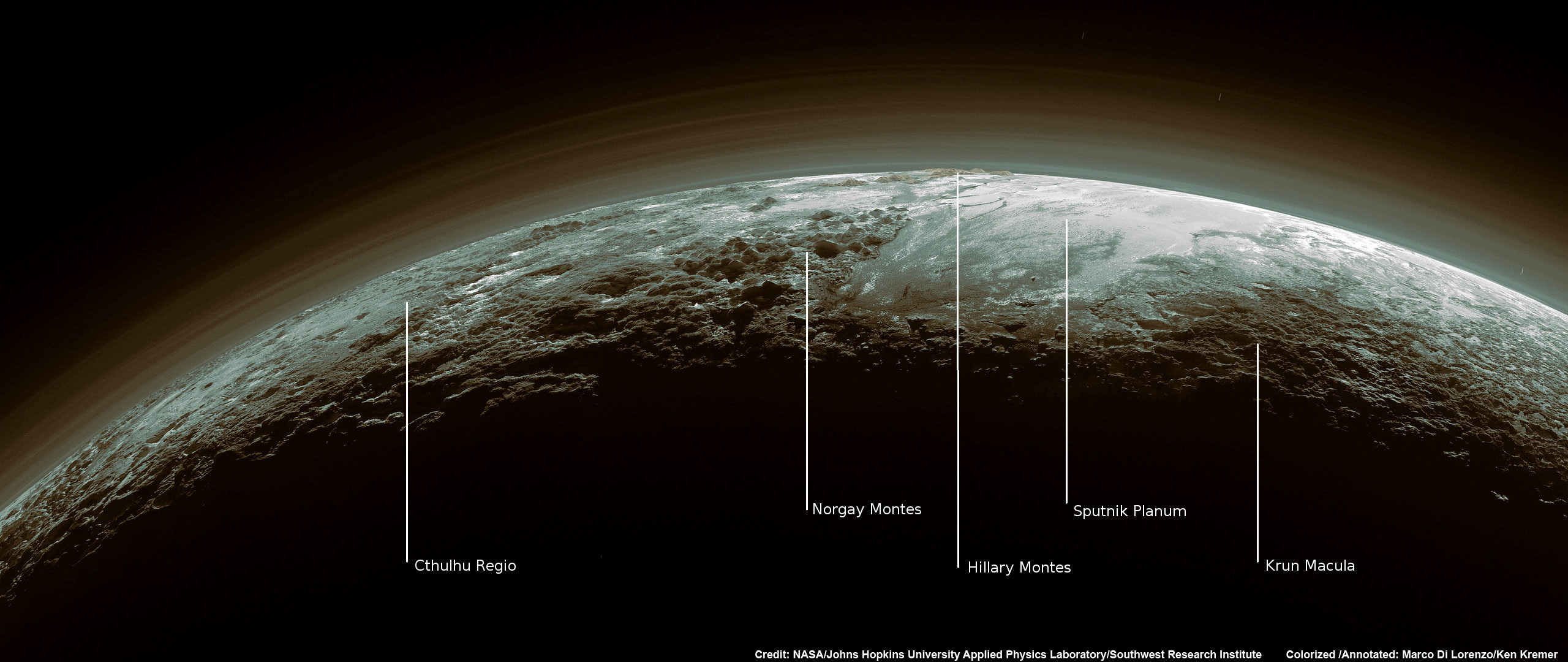The more we learn about Pluto, the weirder and weirder it gets.
The newest batch of high resolution Plutonian images has yielded “astonishing” discoveries of previously unseen ‘snakeskin’ textured mountains, that are simultaneously “dazzling and mystifying” scientists analyzing the latest data just returned from NASA’s New Horizons spacecraft.
New Horizons swooped past the Pluto planetary system during mankind’s history making first encounter on July 14, 2015 at a distance of 50,000 miles (80,000 kilometers).
The piano shaped probe gathered about 50 gigabits of data as it hurtled past Pluto, its largest moon Charon and four smaller moons.
Data from that priceless, once in a lifetime flyby is now trickling back to Earth.
The ‘snakeskin’ feature on Pluto’s utterly bizarre surface was unveiled to “astonished” scientists scrutinizing the latest data dump received over the past week, that included images taken by the Ralph instruments Multispectral Visual Imaging Camera (MVIC).
Features as small as 0.8 miles (1.3 kilometers) are resolved in detail.
The MVIC image stretches about 330 miles (530 kilometers) across the ‘snakeskin’ like landscape composed of rounded and bizarrely textured mountains that are informally named Tartarus Dorsa and that borders the bodies day-night terminator.
It shows intricate patterns of blue-gray ridges and reddish material in between that are puzzling researchers.
“It’s a unique and perplexing landscape stretching over hundreds of miles,” said William McKinnon, New Horizons Geology, Geophysics and Imaging (GGI) team deputy lead from Washington University in St. Louis.
“It looks more like tree bark or dragon scales than geology. This’ll really take time to figure out; maybe it’s some combination of internal tectonic forces and ice sublimation driven by Pluto’s faint sunlight.”
The Ralph/MVIC image is actually a composite of blue, red and infrared images.
The image of Tartarus Dorsa reveals a “multitude of previously unseen topographic and compositional details. It captures a vast rippling landscape of strange, aligned linear ridges that has astonished New Horizons team members,” say officials.

Another wider angle global view of Pluto downlinked on Sept. 19 shows a new “extended color” view of Pluto with an the extraordinarily rich color palette of the planet.
“We used MVIC’s infrared channel to extend our spectral view of Pluto,” said John Spencer, a GGI deputy lead from Southwest Research Institute (SwRI) in Boulder, Colorado.
“Pluto’s surface colors were enhanced in this view to reveal subtle details in a rainbow of pale blues, yellows, oranges, and deep reds. Many landforms have their own distinct colors, telling a wonderfully complex geological and climatological story that we have only just begun to decode.”
The image resolves details and colors on scales as small as 0.8 miles (1.3 kilometers).

Beyond MVIC, additional new images taken by New Horizons’ narrow-angle Long Range Reconnaissance Imager (LORRI) during the July 14 were downlinked on Sept. 20.
They focus on the Sputnik Planum ice plains on the left side of the famous heart shaped Tombaugh Regio feature and are the highest resolution yet – as seen below. The team added color based on the global MVIC map shown above.

Barely 5 or 6 percent of the 50 gigabits of data captured by New Horizons has been received by ground stations back on Earth.
“With these just-downlinked images and maps, we’ve turned a new page in the study of Pluto beginning to reveal the planet at high resolution in both color and composition,” added New Horizons Principal Investigator Alan Stern, of SwRI.
“I wish Pluto’s discoverer Clyde Tombaugh had lived to see this day.”
Stern says it will take about a year for all the data to get back. Thus bountiful new discoveries are on tap.

Stay tuned here for Ken’s continuing Earth and planetary science and human spaceflight news.



That lead photo has me wondering if that by itself was worth the cost of the New Horizons mission. Just wow.
After doing some image searches of ripples in various substances (mud, ice, etc.), I find that the parallel ripples which sometimes form across glaciers on Earth are similar, but still not close enough for my taste to explain these features. To my (admittedly untrained) eye, it appears that those “ripples(?)” post-date at least a handful of large impact craters, suggesting an ongoing process. My imagination conjures a persistent regional wind field which is either ablating/melting solid material and then immediately re-depositing it on downwind surfaces, or perhaps simply sculpting semi-solid ices directly into the fantastic shapes we’re seeing. Either way, I can’t get the image of rain moving up/across the windshield of a moving vehicle out of my head.
(The skin of the possessed demon-pig from Princess Mononoke comes to mind as well, but since I can’t relate that to any natural processes….)
Interesting and reasonable hypotheses I’ve not read elsewhere. It’d be great if one turns out to be correct! 😉
And for the life of me, as I look at more & more images of Sputnik Planum I cannot get past the thought of raspberry ice cream melting into a root beer or cream soda float. Too weird.
So awesome. Please tell me there is a green channel and they just haven’t downloaded it yet.
Answering my own question: they already knew there was so little green they didn’t bother packing a filter. Green could be gotten by subtracting red and blue from the broadband white channel, if there was any to be had. Specifically, MVIC maps blue (400-550 nm), red (540-700 nm), near IR (780 – 975 nm) and narrow band methane (860 – 910 nm).
It’s absolutely wonderful, IMO that the last of the “Classic 9” turns out to be ANYTHING but the least! I wonder if (m)any of these unique features will be present on 2014 MU69..? Perhaps such landforms are more common that far out due to the extreme virtually Sol-less environs? ~~~ Or perhaps it’s the outline of part of the Elder God that slumbers there dreamless’ unspeakable, Aeuclidian hide…?
Jaw-droppingly amazing image! I agree with Smokey: the rippled texture is just like rain moving diagonally up the windscreen of a fast-moving car. It also reminds me of the effect you sometimes get when you’re covering a brick wall with gypsum plaster that is too moist and you try to smooth it down with a wet spatula. With the spatula still sliding sideways, you lift it off the surface and get a very similar effect. (Someone forgot to sand that part down.) Just look at the jagged shadows of the ripples in that low-lying smooth grey patch to the right of centre and down a bit (the largest grey patch). The ripples are really high! Grab your snowboard and head for those Plutonian tubes.
I agree with all the comments above! I just keep thinking how much planetary science has changed in the last 40+ years! I remember one of my professors wistfully clearing shelf after shelf of “standard”, pre-space probe books and atlases which were the planetary reference texts of the time–happened as soon as the Voyager probes sent back the first few images. He was floored, but excited at the same time, and told me he would have to revamp most of his lectures in this area. He got some solace, however. Rather than throwing them in the trash, he had a rubber stamp made up with which he had me stamp all of the affected books (and there were dozens!). The stamp said ” FOR HISTORICAL VALUE ONLY”. This was pre-internet time, and he was concerned about the fluidity and dynamic continuously evolving discoveries in the new planetary science field, and how one could stay abreast of all the data…
Great flash-back barometer! I bet he’d have a poo-hemorrhage today!
Fascinating! Rough terrain punctuated by very smooth areas. To me it looks like dunes and frozen lakes. Considering Pluto’s seasonal meteorological variations maybe that’s what this is. Amazing pictures. Big hand to all those who made this project happen.
/hydrazine
This mission could only have been better if we saw Aliens and Buildings on Pluto what a Great Job they all did well done a Fantastic Bit of Science…
agreed. and still more info to come…
we can still look forward to probes at some future date for the KBOs. i’d like to be alive to witness a sedna mission (doubtful), or whatever significantly sized object becomes the most distant yet discovered.
Ok, I’m no scientist, but those are definitely alien buildings designed to built anti-Earth attack ships! Without a doubt! 😉
Actually, I see very similar structures each spring, when the piles of dirty snow melt in the heat of the sun and create these intricate structures. Maybe something to do with the sun heating different materials, sublimating some away, while others remain.